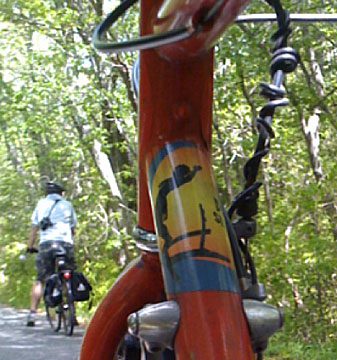World Series Scouting: As Darkness Falls
Images by Charles Eldermire and Hugh Powell May 12, 2011

We spent the morning cruising the asphalt lanes of Belleplain State Forest 

Eastern Wood-Pewees filled the forest with their lazy songs 

Birding by bike puts team captain France Dewaghe in a good mood 

At day's end, Northern Gannets headed out to sea off Cape May 

Minimal noise and maximum visibility—two benefits of bicycle-birding
The Redheads and the Anti-Petrels are in southern New Jersey scouting their routes for the World Series of Birding on Saturday, May 14. More info and scouting reports.
Dusk is gathering under the pines at Belleplain. Swainson’s Thrushes and Veeries called off and on through the day, but what’s ruling the airwaves right now is the irrepressible reep of a Great Crested Flycatcher. It’s 9:00 p.m. and we (the Anti-Petrels) are brushing our teeth. At 2 a.m. we’ll set out to look for night birds, and we’ll keep right on going through dawn chorus. It’s a kind of dry run for the morning of the World Series.
Even though today is Thursday it feels like our last day of scouting. The competition starts at midnight tomorrow, and we’ll spend much of Friday afternoon pumping up bike tires, cleaning our chains, stuffing bike panniers with warm clothes, sun clothes, rainwear, peanut butter, and sunscreen, making coffee ahead of time to drink cold while en route—and then trying to sleep away the evening. We’ll get up at 11 p.m. to get ready for the day.
We’re turning tonight into a partial scouting “day”—taking the opportunity to check some new locations for rails, owls, Whip-poor-will, and Chuck-will’s-widow. We need new spots because we’ve changed our route this year in order to get south to Cape May sooner. There’s a lot to do in Cape May: look for ducks at the Meadows, bird the warbler migration hotspots, spend sunset at a seawatch, and then find a marsh for the last hour or two of darkness.
To gain time at the end of the day, we’ve decided to ride a 10-mile leg of our route while it’s still dark. That has the added benefit of putting us near the shorebirds of Heislerville at an optimal tide. But it’s a gamble—it means we need to spend darkness and dawn at unfamiliar spots. That’s why we’re taking tonight to scout them.
Another worry is that we’ll be coming through the songbird-rich forests of Belleplain in the late morning. We spent this morning coasting Belleplain’s back roads in the cool air, sun slanting through the trees. Worm-eating Warblers chittered so vigorously they nearly fell off their perches. A peevish gnatcatcher scolded from an oak while its mate built a nest of gray lichen high on a stout branch. Hooded Warblers whistled their ribbony songs, tying each into a bow at the end. Two Blue-winged Warblers bee-buzzed at us along the same 100-yard stretch of rough asphalt, and a quarter-mile on a Kentucky Warbler shouted at 30 field-trippers crowded along the road edge.
But all that activity petered out by about 10 a.m. and by 11:00 the Kentucky and Blue-winged Warblers were giving us the silent treatment. These birds have recently returned from the tropics and are preparing to breed, so we’re pretty sure they’ll be here all day on Saturday. But that doesn’t mean they’ll be singing when we ride through. Somehow it’s more painful to miss a common bird that you know is present than it is to miss a rare bird that you’d kill to see any other day of the year—but it’s a risk we’ll have to take.
Every time I go out birding by bike I’m reminded of how these two activities are made for each other. Pedaling slowly enough to keep wind noise to a minimum, the only sounds that compete with chip notes are the humming of our narrow tires over the asphalt. When a bird darts across the road, we just put our feet down and grab our binoculars. There’s no car roof to block out raptors, no corners of the windshield to distort views. When we stop to investigate, there’s no beeping from the ignition key, no car door to remember not to slam.
Bicycling’s main advantages are hard to appreciate until you do them, because they are subtractions rather than additions to the car experience. It’s slower, quieter, and less confined. But after 30 minutes on a bike, the engines of passing cars start to sound as jarring as conversation in a library. Of course, it’s not to say that birding by car is a bad idea—it’s still the main way most of us do most of our birding. But especially in flat areas with good weather, bicycling at a slow pace over as much or as little distance as you please is a great way to immerse yourself in the birds around you.


All About Birds is a free resource
Available for everyone,
funded by donors like you






